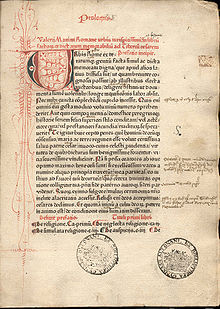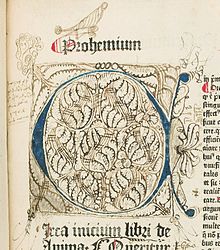


An incunable or incunabulum (pl.: incunables or incunabula, respectively) is a book, pamphlet, or broadside that was printed in the earliest stages of printing in Europe, up to the year 1500.[1] Incunabula were produced before the printing press became widespread on the continent and are distinct from manuscripts, which are documents written by hand. Some authorities on the history of printing include block books from the same time period as incunabula, whereas others limit the term to works printed using movable type.
As of 2021,[update] there are about 30,000 distinct incunable editions known.[2] The probable number of surviving individual copies is much higher, estimated at 125,000 in Germany alone.[3] Through statistical analysis, it is estimated that the number of lost editions is at least 20,000.[4] Around 550,000 copies of around 27,500 different works have been preserved worldwide.[5]
- ^ Greenfield, Jane (2002). ABC of bookbinding: a unique glossary with over 700 illustrations for collectors and librarians. New Castle (Del.) Nottingham (GB): Oak Knoll press The Plough press. p. 37. ISBN 978-1-884718-41-0.
- ^ The British Library Incunabula Short Title Catalogue Archived 12 March 2011 at the Wayback Machine (retrieved 16 August 2021) gives 30,518 editions, though this includes some which have been re-dated to the early 16th century.
- ^ According to Bettina Wagner: "Das Second-Life der Wiegendrucke. Die Inkunabelsammlung der Bayerischen Staatsbibliothek", in Griebel, Rolf; Ceynowa, Klaus (eds.): "Information, Innovation, Inspiration. 450 Jahre Bayerische Staatsbibliothek", K G Saur, Munich 2008, ISBN 978-3-598-11772-5, pp. 207–224 (207f.) the Incunabula Short Title Catalogue lists 30,375 titles published before 1501.
- ^ J. Green, F. McIntyre, P. Needham (2011), "The Shape of Incunable Survival and Statistical Estimation of Lost Editions", Papers of the Bibliographical Society of America 105 (2), pp. 141–175. doi:https://doi.org/10.1086/680773
- ^ Badische Landes-Bibliothek (in German)